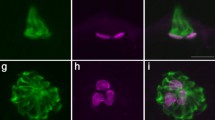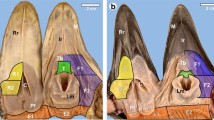Abstract
We investigated lingual taste organs of four frog species mainly by means of fluorescence immunohistochemistry for villin, calbindin, and serotonin. Cells immunoreactive for villin appeared in the taste organs of all the species used. These villin-immunostained cells were basoapically elongated in shape and extended up to the apical surface. They were also immunoreactive for calbindin. On the other hand, serotonin-immunoreactive cells, identified as Merkel-like basal cells, were immunonegative for villin. Considering the present results combined with those of studies by other research groups, the villin-immunostained cells were postulated to function as taste receptors.

Similar content being viewed by others
References
Bretscher A, Weber K (1980a) Villin is a major protein of the microvillus cytoskeleton which binds both G and F actin in a calcium-dependent manner. Cell 20:839–847
Bretscher A, Weber K (1980b) Fimbrin, a new microfilament-associated protein present in microvilli and other surface structures. J Cell Biol 86:335–340
Gilbertson TA, Damak S, Margolskee RF (2000) The molecular physiology of taste transduction. Curr Opin Neurobiol 10:519–527
Hamasaki K, Seta Y, Yamada K, Toyoshima K (1998) Possible role of serotonin in Merkel-like basal cells of the frog, Rana nigromaculata. J Anat 193:599–610
Höfer D, Drenckhahn (1999) Localisation of actin, villin, fimbrin, ezrin and ankyrin in rat taste receptor cells. Histochem Cell Biol 112:79–86
Hozumi I, Iwanaga T, Fujita T, Yamakuni T, Takahashi Y (1986) A Purkinje cell-specific protein (spot 35 protein) showing wide distribution in the endocrine system of some mammals. An immunohistochemical study. Acta Histochem Cytochem 19:545–553
Jaeger CB, Hillman DE (1976) Morphology of gustatory organs. In: Llinas R, Precht W (eds) Frog neurobiology. Springer, Berlin Heidelberg New York, pp 588–606
Kuramoto H (1988) An immunohistochemical study of cellular and nervous elements in the taste organ of the bullfrog, Rana catesbeiana. Arch Histol Cytol 51:205–221
Osculati F, Sbarbati A (1995) The frog taste disc: a prototype of the vertebrate gustatory organ. Progr Neurobiol 46:351–399
Reutter K, Witt M (1993) Morphology of vertebrate taste organs and their nerve supply. In: Simon SA, Roper SD (eds) Mechanisms of taste transduction. CRC Press, Boca Raton, pp 29–82
Takeuchi H, Tsunenari T, Kurahashi T, Kaneko A (2001) Physiology of morphologically identified cells of the bullfrog fungiform papilla. Neuroreport 12:2957–2962
Toyono T, Seta Y, Kataoka S, Harada H, Morotomi T, Kawano S, Shigemoto R, Toyoshima K (2002) Expression of the metabotropic glutamate receptor, mGluR4a, in the taste hairs of taste buds in rat gustatory papillae. Arch Histol Cytol 65:91–96
Toyoshima K, Shimamura A (1988) An immunohistochemical demonstration of neuron-specific enolase in the Merkel cells of the frog taste organ. Arch Histol Cytol 51:295–297
Toyoshima K, Seta Y, Takeda S, Harada H (1998) Identification of Merkel cells by an antibody to villin. J Histochem Cytochem 46:1329–1334
Yamakuni T, Usui H, Iwanaga T, Kondo H, Odani S, Takahashi Y (1984) Isolation and immunohistochemical localization of a cerebellar protein. Neurosci Lett 45:235–240
Yoshie S, Wakasugi C, Teraki Y, Iwanaga T, Fujita T (1991) Fine structure of the taste bud in guinea pigs. II. Localization of spot 35 protein, a cerebellar Purkinje cell-specific protein, as revealed by electron microscopic immunocytochemistry. Arch Histol Cytol 54:113–118
Acknowledgements
The authors are deeply indebted to Prof. Y. Kitada, Department of Oral Physiology, School of Dentistry, Iwate Medical University, for valuable advice and suggestions. This study was supported by a Grant-in-Aid for Scientific Research from the JSPS (number 15591951 to S.Y.).
Author information
Authors and Affiliations
Corresponding author
Rights and permissions
About this article
Cite this article
Yoshie, S., Kumakura, M. & Toyoshima, K. Villin is a possible marker of receptor cells in frog taste organs. Histochem Cell Biol 119, 447–450 (2003). https://doi.org/10.1007/s00418-003-0533-4
Accepted:
Published:
Issue Date:
DOI: https://doi.org/10.1007/s00418-003-0533-4




